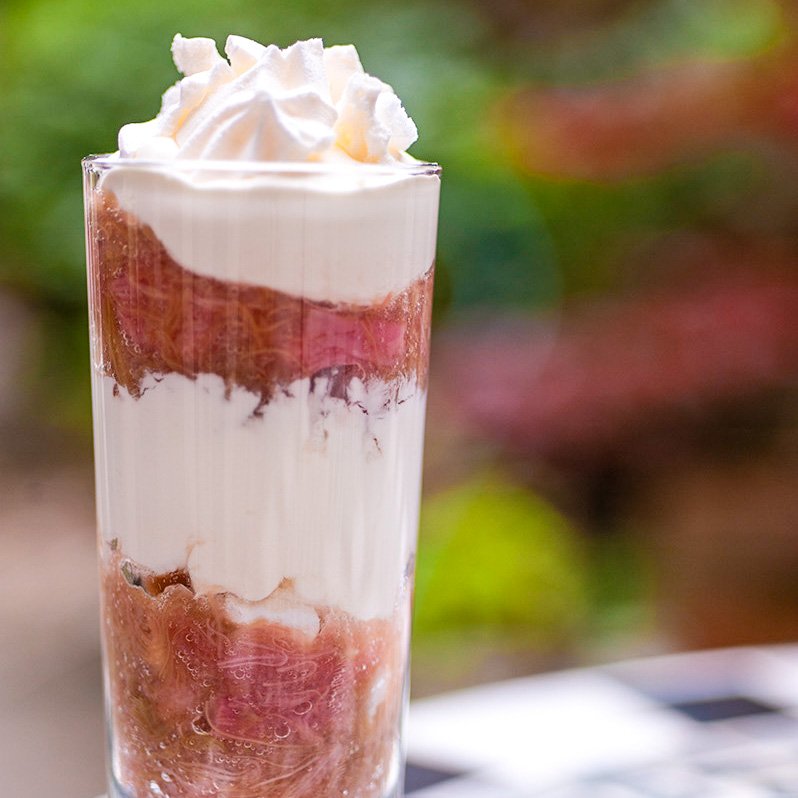Best In Season - May - written by Chef Consultant, Celia Brooks
Rhubarb - not just for crumble!
Luckily I am not trying to be self-sufficient by eating only what I grow on my London allotment, or else I would be very hungry indeed right now. There’s not a fat lot to eat down there at the moment. It’s an odd time of year in the veg patch known in the UK as “The Hungry Gap”. Despite a swathe of botanical exuberance all over the plot, with everything seemingly doubling in size daily (weeds included), it’s all just coming to life, but has a way to go before it’s edible. There’s a sense of “Food, food everywhere, but not a bite to eat”.
Rhubarb is the notable exception. Its early-season delicate pink blush is now erring more towards greenish-red, but it’s busting out more juicy jumbo stalks than I can possibly cook. The glossy hot-pink forced rhubarb that hit the shops back in February is giving way to the outdoor grown varieties that should be readily available to buy until late June. “Field grown” rhubarb may have lost its sexy hue, but it still tastes fabulous - if anything, it tastes deliciously rhubarb-ier. It might need a little extra sweetness added.
But let’s face it - there are only so many rhubarb crumbles, cakes, tarts and fools you can handle before you start reaching for your elasticated-waist trousers.
You may be surprised to learn that here’s plenty you can do with rhubarb in the savoury zone. Its acidity lends itself well to any dish where you’d use lemon - including fish and chicken. Simmer it with sugar and spices for a sweet-sour relish to accompany pork or grilled goats cheese. In the plant-based realm, it marries beautifully with all beans and pulses - try cooking down a couple of sliced stalks in a spicy lentil dal for a surprisingly delicious tang. It can be finely sliced and sprinkled in salads, or cut in finger-long pieces, oiled and roasted with potatoes, sweet potatoes or beetroot.
Now back to the dessert zone, where rhubarb really shines. You simply can’t beat a crumble, with lashings of custard of course, or my preferred lazy go-to - squirty cream. If you fancy something a little more refined but still dead easy to make, try my Rhubarb Rose Eton Mess recipe here. If you really want to go to town, bake your own large soft meringue nests and make a pavlova. Save or freeze the egg yolks from the meringue and make fresh custard for your next crumble.
Rhubarb has amazing health benefits too - is there nothing this crazy pink stuff can’t do?! It provides powerful antioxidants which boost your immune system, some of which are actually maximised by gentle cooking, as well as good fibre for your gut.
Unfortunately adding bucketfuls of refined sugar to the mix isn’t considered healthy eating. But don’t despair! Make a super healthy and monumentally tasty rhubarb compote that won’t spike your insulin levels or land permanently on your waistline. Just cook it down with generous amounts of a natural low-calorie sweetener such as xylitol, stevia or erythritol. Cool and chill, or place in large zip-seal bags, lay flat on a tray and freeze for adding to smoothies, or thaw slightly and mash for a virtually calorie-free slush.
Rhubarb Rose Eton Mess
From “New Urban Farmer” by Celia Brooks, published by Quadrille
Photo credit: Jill Mead
In this elegant dessert, the mysterious perfume of rosewater meets rhubarb’s quirky tartness, suspended in pillows of cream and crunchy meringue. This is super easy to make, and should be made a few hours ahead or the night before, then assembled just before serving.
Serves 4
Ingredients
300g rhubarb (trimmed weight), sliced
75g caster sugar
4 individual meringue nests (store-bought are fine)
300ml double cream
1-2 Tbsp rosewater, or to taste
Method
Place the rhubarb and sugar in a saucepan over a medium heat and cover. When the sugar melts and it starts to boil, stir, lower the heat to a simmer and cook uncovered for 10 minutes, stirring once or twice. Remove to a heat-proof bowl and leave to cool completely, then chill.
When ready to serve, crumble the meringues into a bowl, leaving them in a few bite-size chunks. Whip the cream until it holds it shape and forms soft peaks, but do not over-whip so that it is stiff. Add the rosewater, starting with 1 Tbsp, and beat briefly until thick again. Taste and add more rosewater if you think it needs it – the flavour should be subtle but recognisable.
Stir the cream mixture through the meringues, then fold through the rhubarb so it is streaky but not evenly combined. Spoon into a serving bowl and serve. (Alternatively, construct each portion with layers of meringue, cream, and rhubarb in individual wine or cocktail glasses, adding a topping of crumbled meringue.)


